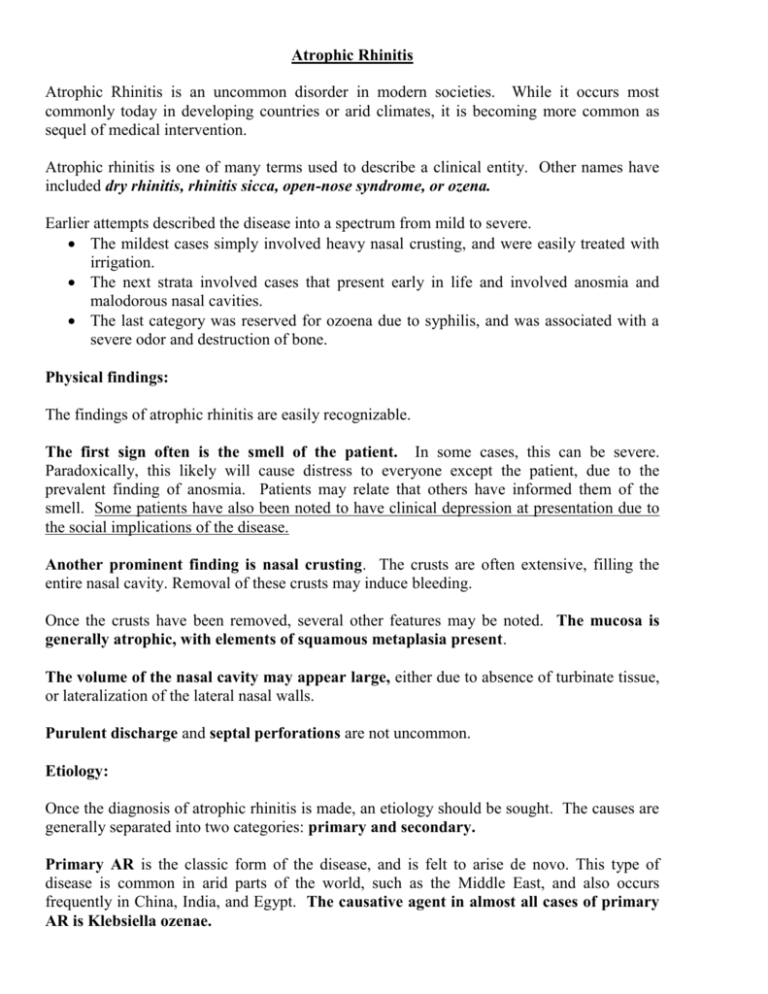Several treatments
advertisement

Atrophic Rhinitis Atrophic Rhinitis is an uncommon disorder in modern societies. While it occurs most commonly today in developing countries or arid climates, it is becoming more common as sequel of medical intervention. Atrophic rhinitis is one of many terms used to describe a clinical entity. Other names have included dry rhinitis, rhinitis sicca, open-nose syndrome, or ozena. Earlier attempts described the disease into a spectrum from mild to severe. The mildest cases simply involved heavy nasal crusting, and were easily treated with irrigation. The next strata involved cases that present early in life and involved anosmia and malodorous nasal cavities. The last category was reserved for ozoena due to syphilis, and was associated with a severe odor and destruction of bone. Physical findings: The findings of atrophic rhinitis are easily recognizable. The first sign often is the smell of the patient. In some cases, this can be severe. Paradoxically, this likely will cause distress to everyone except the patient, due to the prevalent finding of anosmia. Patients may relate that others have informed them of the smell. Some patients have also been noted to have clinical depression at presentation due to the social implications of the disease. Another prominent finding is nasal crusting. The crusts are often extensive, filling the entire nasal cavity. Removal of these crusts may induce bleeding. Once the crusts have been removed, several other features may be noted. The mucosa is generally atrophic, with elements of squamous metaplasia present. The volume of the nasal cavity may appear large, either due to absence of turbinate tissue, or lateralization of the lateral nasal walls. Purulent discharge and septal perforations are not uncommon. Etiology: Once the diagnosis of atrophic rhinitis is made, an etiology should be sought. The causes are generally separated into two categories: primary and secondary. Primary AR is the classic form of the disease, and is felt to arise de novo. This type of disease is common in arid parts of the world, such as the Middle East, and also occurs frequently in China, India, and Egypt. The causative agent in almost all cases of primary AR is Klebsiella ozenae. Secondary AR is the most common form of the disease in developed countries. The most common cause is sinus surgery, followed by radiation, trauma, and granulomatous or infectious diseases. Granulomatous diseases which may result in AR include sarcoid, leprosy, and rhinoscleroma. Infectious causes include tuberculosis and syphilis. Although infection may not be the causative agent in secondary AR, superinfection is uniformly present, and is the cause of the crusting, discharge, and foul odor. In these cases, K. ozenae comprises a small proportion of secondary infections. Infectious: Primary AR is almost always associated with a single organism K. ozenae. Dietary: Anemia, hypolipoproteinaemia, vitamin A deficiency Hereditary: An autosomal dominant inheritance pattern Hormonal: Worsening of the disease has been reported with menstruation or pregnancy Vascular: Overactive sympathetic activity Radiographic findings Radiographic findings of AR can be noted with both primary and secondary diseases, but no signs have been noted to differentiate between the two entities. Changes involving the nasal cavities can be found on plain film or CT scans. Plain films may show lateral bowing of the nasal walls, reduced or absent turbinates, or hypoplastic maxillary sinuses. (Several classic findings have also been noted on CT scan, which include: •Mucoperiosteal thickening of the paranasal sinuses •Loss of definition of the osteomeatal complex secondary to resorption of the ethmoid bulla and uncinate process. •Hypoplasia of the maxillary sinus •Enlargement of the nasal cavities with erosion and bowing of the lateral nasal wall. •Bony resorption and mucosal atrophy of the middle and inferior turbinates.) Mucosal changes: Analysis of the nasal mucosa has similar findings in both primary and secondary diseases. In atrophic rhinitis, the epithelial layer undergoes squamous metaplasia, and subsequent loss of cilia. (This contributes to loss of nasal clearance, and failure to clear debris). The mucous glands are severely atrophic or absent, which results in the common term “rhinitis sicca”. There is also small vessel disease, endarteritis obliterans, which some consider a causative factor, and others consider a result of the disease process. Medical therapies The overall therapy encompasses two main goals: Restoration of nasal hydration Minimization of crusting and debris. To achieve these goals, several broad classes of therapies may be used: topical or local, systemic, or surgical. One of the most widely used treatments is nasal irrigation. This can be used with curative intent or as maintenance therapy. Irrigations are used to prevent the formation of the hallmark extensive crusting. To achieve this result, irrigations must often be done multiple times in a day. As a result, patient compliance is often difficult. No evidence of benefit of one solution over the other has been noted. Suggested formulas include normal saline, a sodium bicarbonate saline solution, or a mixture of sodium carbonate, sodium biborate, and sodium chloride in plain water. The frequency of usage varies, but can be adjusted by the patient as needed to prevent crusting. Solutions given for “curative” intent are used to eliminate purulent discharge and colonization of odor producing bacteria. One of these is Gentamycin 80mg in 1L of normal saline. This is given until resolution of purulence and foul odor. When these solutions are given, it is noted that this does not eliminate the need for continued maintenance irrigations with normal saline or one of the other formulas above. Failure to continue maintenance therapy will result in relapse in almost all cases. Other topical methods are used to prevent drying or increase hydration. These include the application of anti-evaporation compounds. Examples of these compounds noted in the literature include glycerine, mineral oil, or menthol mixed with paraffin. These are usually used as adjuncts, and may be applied following irrigation procedures. Some authors note that odor masking agents, such as rose oil or menthol may be mixed with these applications. Hydration therapies include the application of pilocarpine or atropine to the mucosa to stimulate the remaining mucous glands. Systemic or oral therapies are often used in conjunction with the topical treatments. The most common type of systemic therapy is antibiotics. Early papers refer to treatment of the acute infection process with oral aminoglycoside antibiotics or streptomycin injections. While these were often effective, they are not common practice in recent years due to the toxicity of these medications. Currently, oral antibiotic therapies involve either tetracycline or a floroquinolone. Just as the “curative” irrigations, these are only given to resolve the purulent discharge and foul odor, and then are discontinued in favor of maintenance irrigation therapy. Numerous other oral therapies have been suggested. Subjective improvement was noted in >80% of patients placed on vitamin A therapy in one study. Another noted that treatment with iron resulted in improvement in 50% of subjects. Although they may be effective, no trials of these supplements has been conducted, and widespread usage has not been reported. Other therapies have been suggested based on individual responses. These include potassium iodide to increase nasal secretions Vasodilators to increase blood flow to the atrophic mucosa Estrogen therapy to prevent the worsening that may be associated with menstruation. Corticosteroids have been proposed as an adjuvant by some, but others consider nasal steroids contraindicated in this condition. Vasoconstrictors for subjective nasal congestion are contraindicated due to the poor vascularization of the mucosa. Surgical therapies In almost all cases, even with maximal medical management, patients will continue to have crusting, and may relapse to frank ozena if maintenance therapy is suspended. In attempts to avert the need for lifelong therapy, numerous surgical therapies have been attempted. The procedures fall into three general categories, Denervating operations, Volume reduction operations, Nasal closure operations. The denervating operations are based on the conclusion that sympathetic overactivity plays an integral role in the pathogenesis of this disease. Most of these therapies were proposed and performed over fifty years ago. They were often invasive, results from the operations were not consistent, and the procedures have not been considered advisable first line treatments in recent review articles. Common denervation procedures include Cervical sympathectomy Stellate ganglion block Sphenopalatine ganglion block Section of greater superficial petrosal nerve. Nasal closure operations were introduced by Young. He proposed that functionally closing the nostrils would prevent the drying effects of environmental air, and thus reduce the crusting, and allow the underlying mucosa to heal. (The original procedure involved the elevation of a intranasal flap 1 cm cephalic to the alar rim. This flap was then closed centrally at the nostril. The sides were staged at several months apart to allow for a functional nasal airway. Common problems with this approach were breakdown of the suture line resulting in failed closures, technical difficulty in flap elevation, underestimation of necessary flap length resulting in flap failure, stenosis following takedown, and recurrence of the condition after takedown. Modifications to this procedure were proposed by El Kholy, which involve elevation of an extended mucoperichondrial flap through the a contralateral hemitransfixion incision. This flap was then attached to a short lateral flap elevated from an intercartilaginous incision. These modifications made the procedure more technically feasible, but was still associated with recurrence after takedown. In addition, this procedure may not be possible due to the incidence of large septal perforations in this disease. Before performing any of these closure procedures, the nature of the disease should be assessed. If atrophic rhinitis developed secondary to a destructive process, such as cancer, surveillance of this disease is warranted. If closure is performed in these cases, some authors report making a slit in the closure periodically for endoscopic examination). Volume reduction procedures attempt to provide a cure or control of the disease while avoiding the complications of nasal closure. Numerous materials and methods have been described. Commonly described procedures using natural material include autograft bone, dermofat, cartilage, Xenograft substances such as boplant. Foreign materials include silicon, silastic, acrylic, teflon, hydroxyapatite, or plastipore. In general, the autograft or xenograft substances have very low extrusion rates. However, they also have high reabsorption rates and subsequent failure. Foreign materials should be chosen based on the known extrusion or rejection rates of each substance. Newer implantable materials with smaller pore sizes tend to allow better tissue ingrowth, and tend to have lower extrusion rates. An example of a micropore substance with good tissue properties is plastipore. This material has been implanted in AR cases with low extrusion and complication rates. The implant is placed along the nasal floor and septum, and extends posteriorly to the end of the hard palate. Results of this procedure have been good with substantial reduction in crusting in most patients. Biocompatable materials, such as hydroxyapatite have also been used. A technique describing a degloving incision with elevation of the nasal floor and septal mucosa has been described. The hydroxyapatite / calcium triphosphate substance is then mixed with fibrin glue and inserted along the medial nasal wall and floor. Several leaks were noted during this procedure, and these were often complicated by post-operative infections. Attempts to restore the normal nasal anatomy by recreating turbinate tissue have been described. These involve bone grafts, may be technically difficult, and are associated with resorption of the grafted tissue. Numerous other therapies have been suggested in recent literature. A method for nonsurgical nasal closure that may provide similar results involves the creation of a nasal obturator. This is performed using standard ear mould techniques. The obturator is then cast using clear silicon. These can be worn with minimal cosmetic effects, while providing easy access for examination and routine cleaning. Other reported treatments include techniques from deep nasal acupuncture, to intranasal diversion of the parotid duct.







